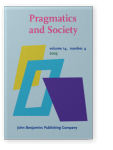Vol. 14:4 (2023) ► pp.568–592
Variation and society
The periphrases tener/haber que + infinitive by sex/gender of participants in Spanish
In Spanish, tener que and haber que + infinitive are modal periphrases that convey deontic meanings. The present investigation analyzes these periphrases as variants used in diverse communicative settings by different kinds of participants, acting as either speakers/writers or addressees. Tener que + infinitive tends to appear in those contexts where a more striking implication or unavoidable recommendation is needed. Haber que + infinitive is used more in a wide range of genres promoting a desubjectivizing-deontic meaning. As for the sex/gender of the participants, men more frequently use tener que + infinitive, whereas women tend to employ haber que + infinitive. The latter feature was also found to be significant when the sex/gender of the addressee is unknown; also, tener que + infinitive resulted more frequently in texts to be read or listened by women. The sociolinguistic distribution of the meanings conveyed by each periphrasis helps to delineate communicative styles based on the objectivity-subjectivity dimension.
Article outline
- 1.Variation between modal periphrases and the cognitive-functional framework
- 2.Modal deontics and desubjectivization
- 3.Sociolinguistic analysis: The sex/gender of speakers and addressees/audience
- 4.Methodology and corpus
- 5.Results
- 5.1Variation across texts
- 5.2Variation across sex/gender of participants
- 5.3Communicative styles
- 6.Conclusions
-
References
